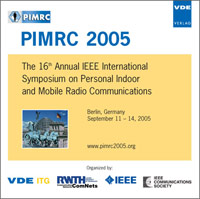Time Diversity inWCDMAFDD Downlink for Multimedia Broadcast/Multicast Services using Chip Block Interleaving
Conference: PIMRC 2005 - 16th Annual IEEE International Symposium on Personal Indoor and Mobile Radio Communications
09/11/2005 - 09/14/2005 at Berlin, Germany
Proceedings: PIMRC 2005
Pages: 5Language: englishTyp: PDF
Personal VDE Members are entitled to a 10% discount on this title
Authors:
Quddus, A. U.; Tafazolli, R.; Evans, B. G. (Mobile Communications Research Group, Centre for Communication Systems Research (CCSR), University of Surrey, Guildford, GU2 7XH, Surrey, UK)
Abstract:
Multimedia Broadcast / Multicast Service (MBMS) is introduced in the Release 6 of the 3rd Generation Partnership Project (3GPP) and is characterized by relatively longer interleaving depth. This paper investigates the exploitation of the longer interleaving depth by chip block interleaving to obtain intra-bit diversity. Both terrestrial and satellite modes of MBMS delivery mechanisms are studied and it is found out that chip block interleaving provides a reduction in the transmission power (2.5 dB in terrestrial flat Rayleigh fading channel, 0.75 dB in 4- tap 3GPP Case 3 radio channel, 1.5 dB in satellite line of sight Ricean flat fading channel and 0.7 dB in 9-tap satellite multipath fading due to intermediate module repeaters) at moderate speeds of 30 - 50 km/h and a moderate interleaving depth of 20 ms for 64 kbps data service. Moreover, it is also shown that for terrestrial mobile radio channels, the gain provided by chip block interleaving with block length equal to half the spreading factor and using only one transmit antenna is equal to that provided by Space Time Transmit Diversity (STTD) that requires two transmit antennas.


